Lewmar has built an impressive range of anchors over the years. Their flagship anchor, the Delta anchor, is the primary Lewmar anchor used by numerous national lifeboat organisations worldwide. With such a wide range of anchors available and a choice of three materials, it can be tricky to know which Lewmar anchor is best for your boat. This blog will discuss the most popular Lewmar anchors and how to choose the best anchor for your boat based on holding power and they types of sea beds you are likely to be mooring in.
Claw Lewmar anchor
One of the most popular Lewmar anchor choices in north America, originally designed to secure oil rigs in the north sea. The claw anchor is an excellent all-purpose anchor which sets extremely easily in most soft surfaces and resets easily if broken loose. One downside to this Lewmar anchor is that it often has less holding power than other anchors of a similar size such as the delta, meaning you will most likely have a much larger, heavier and bulkier anchor on board, if you opt to go with the claw.
Good in: Mud, sand, rock, coral
Not so good in: Clay, heavy grass and weeds
Materials: Galvanised or stainless steel
Range: 1 - 80 kg
LFX Lewmar anchor
A relatively modern design, the LFX anchor has an adjustable fluke angle, which can be used to adapt to different water and seabed conditions. The LFX is considered one of the best designs for mud and sand, the downside is that outside of these two elements, it is not nearly as effective. Fortunately, most sea bottoms are comprised of mud and sand. Whether or not it is used as a primary anchor, a LFX anchor makes an excellent choice as a secondary or stern anchor. When not in use, the LFX can be disassembled and stored in a bag or locker.
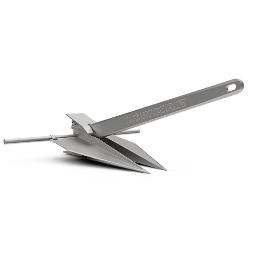
Good in: Mud, sand
Not so good in: Rock, coral, clay, heavy grass and weeds
Materials: Aluminium
Range: 2 - 10 kg
LFF anchor
The LFF is a smaller version of the LFX anchor, designed for smaller yachts. The simple, yet strong LFF anchor is ideally used as a secondary anchor as it provides great holding power, easy stowage and can be used in a number of mooring applications.
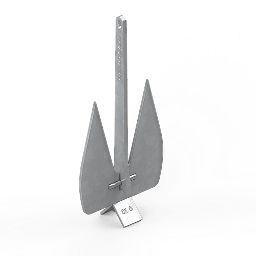
Good in: Mud, sand
Not so good in: Rock, coral, clay, heavy grass and weeds
Materials: Galvanised steel
Range: 6 - 25 kg
Plow style Lewmar anchors
Delta® anchor
The Delta® is one of the oldest styles of anchor, dating back to the 1930s. However, it has withstood the test of time and continues to be one of the most popular anchors on the market today. The Delta® anchor uses a design similar to an agricultural plow, with a sharp point, rather than a blunt end to make insertion in to soft sea beds easy. The low centre of gravity and self-righting geometry mean that the Delta® will set immediately. Plus, it has great holding power for it’s size; about 50% more than the Claw. However, the Delta's® sharp end is not as effective in sea floors with rocks that it cannot penetrate and can be damaged more easily by hard surfaces.
Materials: Galvanised or stainless steel
Range: 4 - 63 kg
DTX anchor
The Lewmar DTX anchor fills the gap between the existing galvanised and stainless Delta® anchors, allowing owners to have a stainless steel anchor for a significantly reduced outlay. The DTX anchor is made of 316 stainless steel and incorporates a lead ballast encapsulated within the tip of the anchor to achieve the perfect centre of gravity with even greater precision.
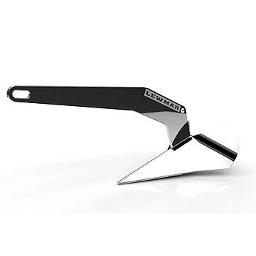
Materials: Galvanised or stainless steel
Range: 6 - 63g
Epsilon anchor
The latest in the Lewmar anchor range and a natural progression of the Delta® anchor. This is a compact, robust version of the Delta® with extreme holding power and rapid setting for it’s size. Its concave fluke and ballast keel ensure market-leading holding power and rapid setting, while maintaining self-launching characteristics with Lewmar bow rollers and retaining the same shank geometry as the original Delta®.
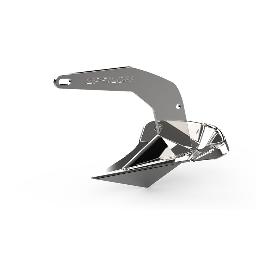
Materials: Galvanised or stainless steel
Range: 6 - 63g
CQR Lewmar anchor
The CQR is very similar to the Delta® design, with the biggest difference being the hinge feature. The hinge allows this anchor to be much more responsive to changes in wind and tide when compared to other anchor types. Despite this, it has relatively low holding power compared to the fixed Delta® design.
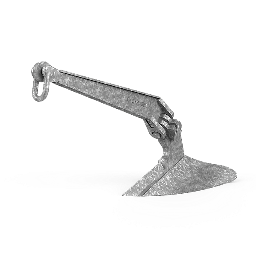
Good in: mud, sand, coral, clay, heavy grass and weeds
Not so good in: Rock
Materials: Galvanised or stainless steel
Range: 7 - 408 kg (that is a big anchor!!!)
Lewmar Anchor Materials
The Lewmar range of anchors come in three materials, galvanised steel, stainless steel and aluminium alloy. Galvanised and stainless steel have very similar holding power and weight, the main difference being the aesthetic appearance of the stainless steel. The polished stainless steel is more prone to scratches and other aesthetic damage over time, whereas galvanised steel masks this with it’s uneven finish.
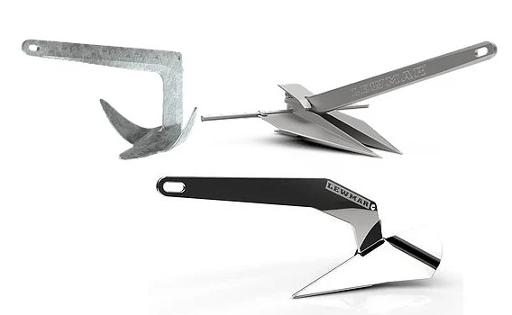
Aluminium is the lightest of the three and is more prone to corrosion and damage than steel (only available in the LFX model). While light weight is usually a big plus in sailing hardware, this means that aluminium anchors must rely much more on bottom penetration, for holding power, and if they are not set properly, they will provide little to no holding power.
Conclusion on Lewmar anchor
The anchor and material you choose depends heavily on a number of factors. For most sailors a Delta® variant or Claw is the best balance between great performance and low price point. For blue water cruisers, the CQR or LFX are much more forgiving of current and wind changes, so are a great option for more dynamic environments.
If you have any questions about Lewmar anchors, please feel free to email us at [email protected], or click the link below to see our full range:


Which is the right Lewmar anchor for my boat?